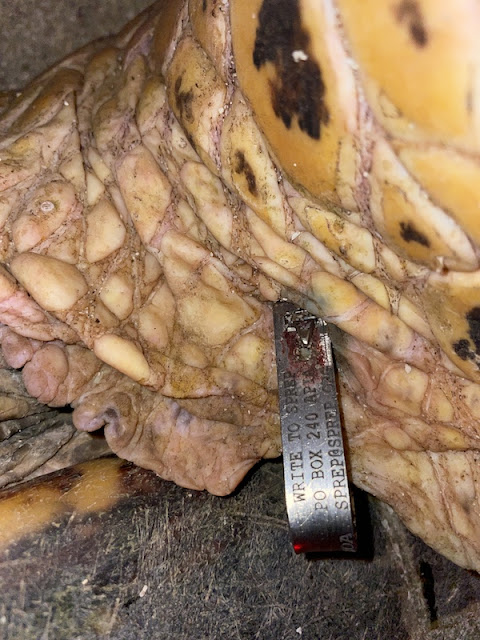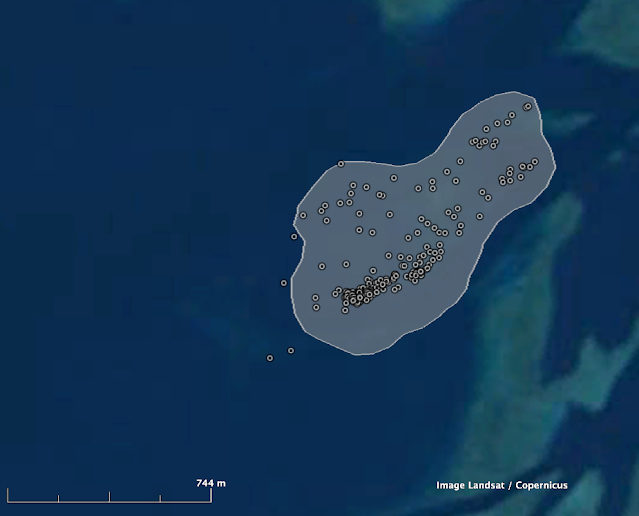We had a successful night last night. We were able to capture a beautiful post-nesting hawksbill turtle and attach a satellite tag to her. She was first observed at 2010 and captured as she made her way back to the beach at 2025. Below is a picture of the capture team.

After a few hours sleep, I would like bring you up to date on last night's activities. We traveled from TR to the base camp around 1730 hours, set up camp and prepared dinner. After dinner we rested for a couple of hours before we made our first beach survey. Two teams headed out, one to the east (long beach) and one to the west beach area. As soon as we came out onto the beginning of the longest stretch of west beach, Annika and Alden came across a track! We stood and listened for a few minutes and could hear the thrown sand (mama turtle covering her nest) and knew she might be close to finishing her nesting (nest location: Latitude: 17° 31’ 19.752” S, Longitude: 168° 14’ 26.052” E). We radioed back to the base station and Robson and Peter (two of the Tassiriki guides) came running with the containment box. They got to the site just a few minutes before mama came bursting out of the underbrush and down the incline toward the beach. The team was there and ready, and the box was placed around Mama (she was named Makala which is the name of the location where she was captured.
Once she was contained, the team got all of the tagging equipment ready and we set to work. Catherine and Annika sanded the shell where the tag would be placed while Alden and Charlotte got the fiberglass cloth and other materials ready to begin the attachment.
Mr. Rice mixed the polyester resin with the UV activation powder and a couple of drops of MEK catalyst and we were ready to begin. Ms. Jim took down all of the measurement, tag numbers (Makala had been tagged previously) and managed and directed us all (she was also the official photographer).
Below are a series of pictures of the tagging showing the participants and the attachment operations.
Makala's tag was attached and the resin solidified enough for release at 2130 hours. The box was removed and she made her way back to the ocean, hopefully to share her journey back to her home forage grounds with us over the next year or two.
 |
| Patrolling the beach using red light to keep from scaring the turtles. |
 |
| Annika calms Makala by shielding her eyes. The Iridium Satellite tag is seen attached to the second central scale or scute. |
 |
| Adding resin to the fiber glass cloth. |
 |
| Charlotte and Alden. |
 |
| Catherine and Annika helping to control Makala. |
 |
Makala's completed nest ( /""""""""""""""""""""""""""""""""""""""""""""""""""""""""""""""""""""""""""""""""""""""""""""""""""""""""""""""""""
Latitude: 17° 31’ 19.752” S, Longitude: 168° 14’ 26.052” E). |
 |
| Catherine with one of our UV flashlights thatwe use to help solidify the resin. |
 |
| Makala measured 89 cm curved carapace length. |
 |
| Makala had been previously tagged... we are waiting to find out the history of the tagging. |
 |
| Checking the attachment and dryness of the resin. |
 |
| As we were putting on the resin, Makala would move around the box and flip sand up (onto the drying resin), so we tried to keep her as quiet as possible. |
 |
| Annika and Charlotte while the resin solidifies. |
 |
| The magnificent team of Chatherine, Annika, Charlotte and Alden with Makala - tag attachment is complete and we are giving the resin a little time to cure. |
This is a short video as we released Makala and she made her way back to the ocean
 |
| Magroves line the inner lagoon shoreline as seen on our way back to TR this morning. |
 |
| The northern Moso Island shoreline. |
 |
| Beautiful Mangroves along the inner shoreline of Moso Island near Tassiriki Village. |
 |
Leaving Tassiriki Village on our way back to TR this morning.
|






















Comments
Post a Comment